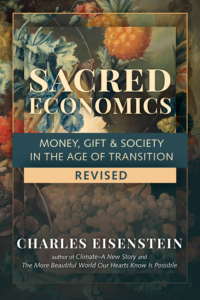Climate — A New Story
Chapters
Chapter 4: The Water Paradigm
The Forests and the Trees
An alive planet is a resilient planet, capable of responding to fluctuations in atmospheric gases, volcanic eruptions, asteroid impacts, solar fluctuations, and other challenges. Standard climate theory says that forests have an ambiguous contribution to temperature, contributing to warming because they absorb more sunlight than bare ground, and to cooling by storing carbon. Recently, the trend in research has been to demonstrate that forests store and sequester much more carbon than previously thought. According to one paper, if we continue current rates of deforestation then the planet will warm by 1.5 degrees even if fossil fuels were eliminated overnight.[1] These computations did not include lost sequestration potential, but only the carbon from the lost biomass and exposed soil. (Deforestation exposes soil to heat and erosion, leading to massive emissions of carbon dioxide.)
On carbon grounds alone, forest conservation and reforestation should be much higher priorities than they are today. Through the lens of water, their importance is even more critical.
Because forests store and transpire moisture, they convert solar radiation into the “latent heat” of water vapor. Some of this heat is released back at night when the water vapor condenses into dew, but a lot of the vapor rises to form clouds, transferring heat from the ground level into the atmosphere. When the water condenses as clouds, the heat is released again. How much of that heat radiates out into space and how much returns back to earth is a contentious matter—the effect of clouds is one of the most important and controversial variables in climate modeling[2]—but there is little doubt that forest transpiration has a cooling effect on at least a local and regional level; there are also strong arguments that the same is true on a global level.
Intuitively, everybody already knows that it is much cooler in the forest (during the day, and a bit warmer at night). Research confirms this commonsense knowledge. One study in the Czech Republic compared air temperatures under conditions of high solar irradiance (i.e., sunny days) on neighboring parcels of wet meadow, harvested meadow, asphalt, forest, sparse vegetation, and open water. The air temperature over the wet meadow, lake, and forests was cooler than 30 degrees; the harvested meadow was over 40 degrees and the air above the asphalt nearly 50.[3]
These are local effects; forests also apparently cause regional cooling. Kenya, which has lost most of its forest cover over the last half-century, is also suffering persistent droughts and higher temperatures. Regions in Kenya where the daytime temperature in the forest might be 19 degrees record temperatures in nearby, recently cleared agricultural land of 50 degrees.[4] In Amazonia, pastureland was found to be on average 1.5 degrees hotter (day and night combined) than forested areas despite its higher albedo.[5] In Sumatra, land cleared for palm oil plantations was 10 degrees hotter than nearby rainforest, and stayed hotter even when the palm trees matured.[6]
A real, living forest interacts with the water cycle in complex ways that science is just beginning to understand. One way is by converting humidity to rain. Water vapor in the atmosphere doesn’t necessarily fall as rain, but may instead persist as haze in what is known as a “humid drought.” One reason for the formation of haze is an overabundance of small condensation nuclei, which prevents water droplets from becoming large enough to fall as rain.[7] Pollutants, smoke from forest fires, and dust from desiccated soil are among the culprits in haze formation. Over forests, the condensation nuclei are mainly biogenic, including plant detritus, bacteria, fungal spores, and secondary organic aerosols originating as volatile organic compounds emitted by vegetation.[8] These aid the formation of clouds rather than haze, and allow cloud formation at higher temperatures than abiotic nuclei.[9] Recent research confirms the increased cloud cover over and near forests.[10] These lower, thicker clouds have a greater cooling effect than high-altitude clouds. According to one researcher, a 1 percent increase in albedo from forest-generated clouds would offset all warming from anthropogenic greenhouse gas emissions.[11]
On the other hand, the haze that forms in the absence of forests exercises a powerful greenhouse effect. It lets in the sunlight and covers the earth in an insulating blanket that prevents heat from radiating back into space at night. The result is intense heat and humidity, but no rain. This demonstrates the principle that life creates the conditions for life.
Some of the bacteria that serve as cloud condensation nuclei seem almost custom-designed to seed clouds. The most studied species, Pseudomonas syringae, bears ice-nucleating proteins that allow clouds to form at higher temperatures (and thus lower altitudes) than they otherwise could. Found around the world, they originate as plant pathogens.[12] Their ice-nucleating proteins lead to frost damage on plants, which they are more easily able to feed on. Ominously, crop scientists are working to genetically engineer strains of Pseudomonas syringae that lack the ice-nucleating proteins. This is a typical control-based approach that may have the utterly unanticipated consequence of altering rainfall patterns and intensifying climate change.
Deforestation sets off a vicious circle of drought, extreme weather, and even more deforestation. Familiarity with the water cycle makes it clear why. In a healthy water cycle, evaporated water from the ocean moves over the continents, where it falls as rain. A tiny fraction of that precipitation runs off directly; most of it is absorbed by soil and vegetation, while some percolates into underground aquifers, eventually surfacing as springs that feed streams and rivers. Once the water is in the soil and water table, plants and especially trees steadily transpire it back into the air, providing a source of rain through the dry season. Depending on the region, some 30–90 percent of rainfall originates not directly from the ocean, but from evapotranspiration of water from soil and vegetation.
In vast areas of the earth, trees are critical to the ability of soil to absorb rainwater:
- The leaf litter layer absorbs water and protects moisture from immediate evaporation.
- The shade canopy also slows evaporation.
- Trees and forest fauna increase the porosity of the ground, allowing water to penetrate.
- Tree roots and understory vegetation protect soil from erosion.
Deforestation, on the other hand, leads to soil erosion and the reduced capacity of the land to absorb water, and consequently worse flooding after heavy rains. Furthermore, without the deep roots of trees to bring moisture from deep underground and replenish atmospheric moisture, droughts tend to be longer and drier. This in turn puts greater stress on remaining forests, which become susceptible to fires and disease. When the rains do come, they run off the parched earth, taking the soil with them.
Deforestation alters atmospheric circulation in another way: it leads to stronger updrafts and higher clouds, which produce rainfall that is less in total quantity but greater in intensity—aggravating the familiar drought/flooding cycle.[13] The transition from reliable rainfall to the drought/flood pattern exemplifies the aforementioned “climate derangement” that may be a bigger threat than outright global warming. Not only do weather patterns change, but Earth’s ability to handle those changes diminishes.
It gets worse. Forests do more than recycle moisture originating in the oceans; apparently, they actually generate wind patterns that bring the water from the oceans in the first place. It has been a commonplace belief around the world that forests bring the rain, but for a long time scientists scoffed at this notion: forests grow where there is ample precipitation, they said, but they do not cause that precipitation. It comes via winds that are governed by large-scale geomechanical processes originating in polar/equatorial temperature differentials, the spin of the planet, and other factors. Now this view is changing.
In the last decade, a scientific theory called the “biotic pump” has been gaining prominence that validates the universal vernacular wisdom that forests attract rain. First proposed in 2006 by Russian physicists V. G. Gorshkov and A. M. Makarieva, the theory says that evapotranspiration from large forests, especially old growth forests, creates low pressure systems when the water vapor rises and condenses.[14] Because winds generally blow from high pressure to low pressure areas, moisture-laden winds from the ocean are pulled toward forested continental interiors, bringing the rain that in turn maintains the forest.[15] That is why forested continents enjoy reliable, abundant rainfall deep into the interior; that is also why these rains have begun to fail as deforestation approaches critical levels in Amazonia, Southeast Asia, Africa, and Siberia.
The theory sparked intense controversy, as is common when a challenge to long-established dogma comes from outside a discipline (Gorshkov and Makarieva are nuclear physicists, not atmospheric physicists). It is also difficult to prove, either experimentally or through computer modeling; furthermore, it suggests that existing climate models are neglecting an extremely important process. It also carries alarming implications given high levels of deforestation globally. For example, it means that Amazonian deforestation will not lead to a mere 15 percent or 30 percent decrease in rainfall, as conventional models predict, but to as much as a 90 percent decrease.[16] This would mean a transition of Amazonia not to a savanna but to a desert.
Indirect evidence for the biotic pump abounds in the form of droughts and declining rainfall that accompany deforestation from Siberia to Australia to Indonesia to Central America. Total rainfall in the Amazon declined from 1975 to 2003 by an average 0.3 percent a year,[17] in direct correlation to deforestation rates, culminating in severe droughts in 2005, 2010, and 2015. More recently, direct evidence has accumulated as well, based on precipitation patterns and isotope analysis.[18] While the theory defies the geomechanical bias that still exerts strong influence in climatology, it resonates deeply with the living planet perspective. Again, life creates the conditions for life.
Even in the conventional carbon frame, rainforest conservation should be more prominent for its storage and sequestration of carbon. In the living system frame, to preserve and restore forests is a matter of utmost urgency. Today, the number one priority of conventional environmentalism is emissions reduction, but that is the convenient problem, fitting comfortably into the familiar blueprint narrative of the onward march of technology. But the ecological crisis will not be resolved by adjusting a few inputs. We are called to deep partnership with nature and respect for all life.
Crucial forests are tipping into a death spiral: deforesting causing drought, drought causing more deforestation. We have to start protecting forests as if they were sacred (they are), and restoring damaged forests as if our lives depended on it (they do).
The connection between forests, water, and life has always been obvious to people living in deep connection to the land. Here is the Yanomami shaman Davi Kopenawa describing the destruction of the hydrological cycle:
We never tear away the earth’s skin. We only cultivate its surface, because that is where the richness is found. In doing so, we follow our ancestors’ ways. The trees’ leaves and flowers never stop falling and accumulating on the ground in the forest. This is what gives it its smell and its value of growth. But this scent disappears quickly once the ground dries up and makes the streams disappear into its depths. It is so. As soon as you cut down tall trees such as the wari mahi kapok trees and the hawari hi Brazil nut trees, the forest’s soil becomes hard and hot. It is these big trees that make the rainwater come and keep it in the ground.… The trees that the white people plant, the mango trees, the coconut trees, the orange trees, and the cashew trees, they do not know how to call the rain.[19]
Note the last sentence, which asserts that a forest is more than a collection of trees. If we do not see forests as living beings too, will we ever treat them as such?
The necessity of conserving and re-growing forests is undeniable when we see Earth as a living being and the forests as one of her vital organs. The necessity of protecting and revering the water is obvious when we see it as the blood or vital fluid of a living planet. It is the same as for the human body: If you understand it as a coherent, intelligent living system, then you do not need physiological reasons to convince you that yes, you do need your lungs, your liver, your appendix, your tonsils. It is only in a mechanistic view that we would imagine that some organs are useless and could be cut out without repercussions for the whole. Finally today more enlightened doctors are realizing this and overturning seventy years of medical fads like the routine removal of appendixes, tonsils, and wisdom teeth. Isn’t it time we do the same for the Gaian body?
End Notes
[1] Mahowald et al. (2017).
[2] Generally speaking, clouds with lower cloud tops radiate more heat back into space. See Trenberth and Stepaniak (2004).
[3] See Ellison (2017) for an image showing these findings, which originally appeared in Hesslerová et al (2013).
[4] Schwartz (2013).
[5] Runyan and D’Odorico (2016).
[6] Sabajo et al. (2017).
[7] Runyan and D’Odorico (2016), 62.
[8] Ibid.
[9] Thompson (2008).
[10] Teuling et al. (2017).
[11] Jehne (2007).
[12] Schiermeier (2008).
[13] Schellnhuber (2004), 253.
[14] The best introduction to the theory and its significance that I’ve found is this interview with the authors in Hance (2012).
[15] Gorshkov and Makarieva (2006).
[16] Schwartz (2013).
[17] Courcoux (2009).
[18] See, for example, Angelini et al. (2011) and Andrich and Imberger (2013).
[19] Kopenawa and Albert (2013).






